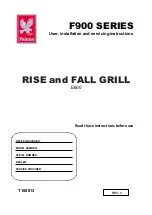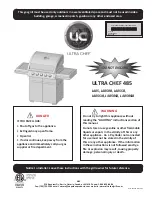
11
7. Liquid Propane Tank Installation
(1)According to step 6, pull the tank tray, and place
the liquid propane tank into the tank tray and tighten
the retention screw to fix the tank as shown in Fig. 12.
(2) Push the tank tray to the end, and then lock the
tank tray slide as shown in Fig. 11.
Liquid Propane Hook-Up
Attach the regulator (A) to the propane cylinder (B)
by turning the regulator handle clockwise as shown
in Fig. 13. If the outdoor cooking appliance is not in
use, the gas must be turned “OFF” at the Liquid
Propane cylinder.
Check all gas supply fittings for leaks before
each use. Do not use the grill until all
connections have been checked and do not leak
(see “Leak Testing” instructions on page 13).
INSTALLATION INSTRUCTIONS
GAS HOOK-UP
Only the pressure regulator and hose assembly supplied with the grill should be used. Any replacement
pressure regulator and hose assembly must be specified by the grill manufacturer.
This grill is configured for Liquid Propane. Do not use a Natural Gas supply.
Total gas consumption (per hour) of the 720-0665 Liquid Propane gas grill with all burners set on “HI”:
Main burners
44,000 BTU/Hr.
Rear burner
13,000 BTU/Hr.
Sear Side burner
15,000 BTU/Hr.
Total
72,000 BTU/Hr.
The installation of this appliance must conform with local codes or, in the absence of local codes, with either
the National Fuel Gas Code, ANSI Z223.1/NFPA 54, National Gas Propane Installation Code, CSA B149.2.
Installation in Canada must be in accordance with the Standard CAN/CGA-B149.2 (installation code for gas
burning appliances and equipment) and local codes.
B
A
Fig. 13
50 100
150 200
250
60
0
500
300
200
400
Fig. 12
Figure 325
CSA International
Project 2070363
12 of 31












































